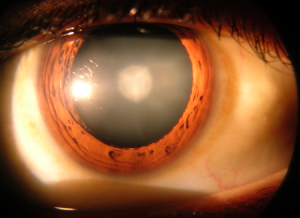Vision Loss and V1
92 Causes of Vision Loss
Learning Objectives
Know what are the major causes of low vision in the U.S.
Be able to identify what parts of the eye are affected by cataracts, macular degeneration, and glaucoma.
Be able to describe the impact of different diseases on different aspects of our visual function (visual acuity vs. visual field vs. night vision).
The leading causes of blindness and low vision in the United States are primarily age-related eye diseases such as age-related macular degeneration and cataract. Diabetic retinopathy and glaucoma are the other leading causes of vision loss. Common developmental eye disorders include amblyopia and strabismus.
Most cataracts are caused by normal changes in your eyes as you get older. When you’re young, the lens in your eye is clear. Around age 40, the proteins in the lens of your eye start to break down and clump together. This clump makes a cloudy area on your lens — or a cataract (Fig.9.2.1). Over time, the cataract gets more severe and clouds more of the lens.

Macular degeneration, often called age-related macular degeneration (AMD), is an eye disorder associated with aging and results in damaging sharp and central vision. AMD affects the macula, the central part the retina that allows the eye to see fine details. There are two forms of AMD, wet and dry, which are covered in more detail in the next section.
Glaucoma is a group of diseases that can damage the eye’s optic nerve and result in vision loss and blindness. Glaucoma occurs when the normal fluid pressure inside the eyes slowly rises. At first, glaucoma doesn’t usually have any symptoms. That’s why half of people with glaucoma don’t even know they have it. Over time, you may slowly lose vision, usually starting with your side (peripheral) vision—especially the part of your vision that’s closest to your nose. Because it happens so slowly, many people can’t tell that their vision is changing, especially at first. But as the disease gets worse, you may start to notice that you can’t see things off to the side anymore. Without treatment, glaucoma can eventually cause blindness. More information about glaucoma is available at the National Eye Institute’s website.
CONTENT SHARED PREVIOUSLY
National Eye Institute, Cataracts
URL: https://www.nei.nih.gov/learn-about-eye-health/eye-conditions-and-diseases/cataracts
License: PDM
Center for Disease Control and Prevention, Common Eye Disorders and Diseases
URL: https://www.cdc.gov/visionhealth/basics/ced/index.html
License: PDM

